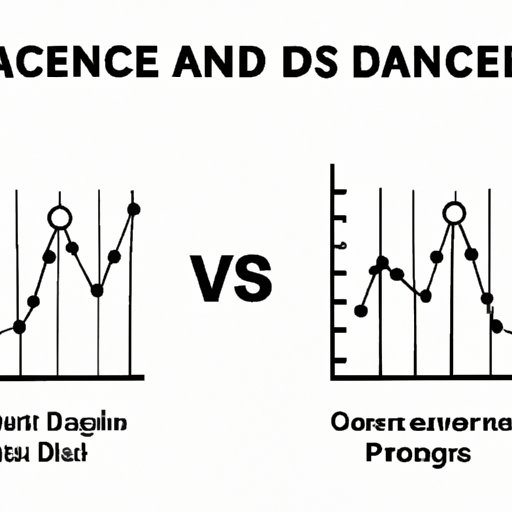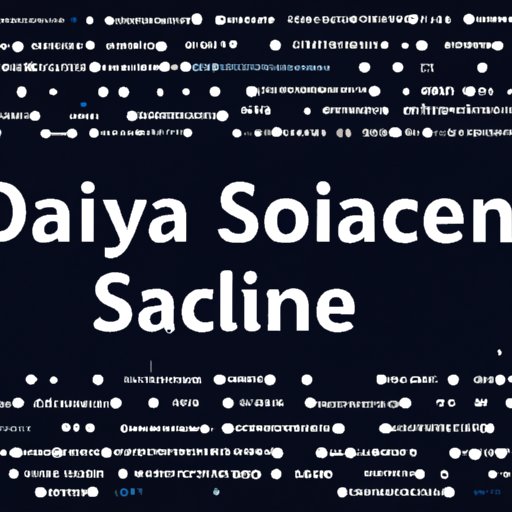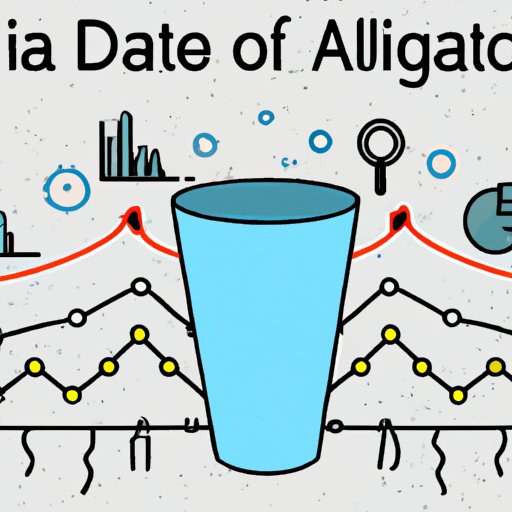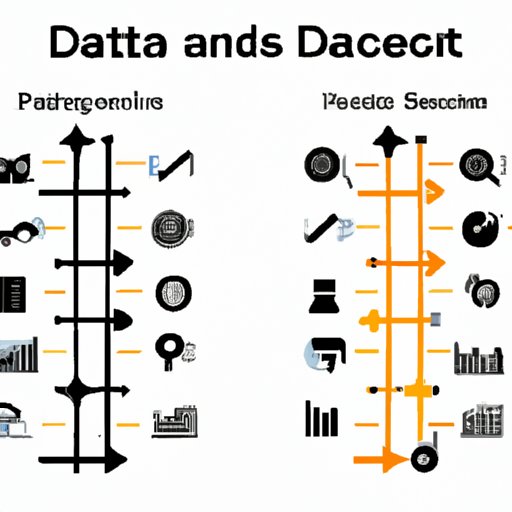Introduction
In today’s world of big data, data science and data analytics have become increasingly important topics to understand. Both are powerful tools used by organizations to make sense of large amounts of data and uncover trends, correlations, and insights that can help inform decisions. But what exactly is the difference between data science and data analytics? Which one is best suited for a particular organization or project? This article seeks to explore these questions and provide a comprehensive guide to understanding the differences between data science and data analytics.

A Comparison of Data Science vs. Data Analytics: Examining the Pros and Cons
Before we dive into the details, it’s important to understand what each of these terms means. Data science is the process of using mathematics, statistics, and computer science to extract knowledge from data. It involves analyzing data to identify patterns, correlations, and trends, and then using these insights to make predictions and decisions. Data analytics, on the other hand, is the process of extracting, transforming, and loading data in order to gain insights and generate reports. Let’s take a closer look at the pros and cons of each.
Overview of Data Science
Data science is a broad field that encompasses many different disciplines, including mathematics, statistics, machine learning, artificial intelligence, and computer science. It involves taking raw data and turning it into actionable insights. The goal of data science is to find meaningful patterns in data that can be used to make better decisions. Data scientists use a variety of tools and techniques to analyze data, such as regression analysis, cluster analysis, natural language processing, and deep learning.
Overview of Data Analytics
Data analytics is the process of collecting, organizing, and analyzing data to uncover insights and generate reports. It involves extracting, transforming, and loading data into a database in order to gain insights and generate reports. Data analysts use a variety of tools and techniques to analyze data, such as SQL queries, statistical analysis, and visualization tools. Data analysts are also responsible for cleaning, formatting, and validating data before it can be used for analysis.
Pros and Cons of Data Science
One of the main advantages of data science is its ability to uncover hidden patterns and correlations in data that may not be obvious at first glance. Data scientists can also use predictive models to make accurate forecasts about future events or trends. Additionally, data science can help organizations make better decisions by providing insights into customer behavior, market trends, and operational efficiency. On the downside, data science requires a lot of time and resources, and it can be difficult to interpret the results. Additionally, data science is still a relatively new field, so there is a lack of experienced professionals.
Pros and Cons of Data Analytics
The main advantage of data analytics is its speed and efficiency. Data analysts can quickly and easily extract, transform, and load data into a database in order to generate reports. Additionally, data analytics can help organizations gain a better understanding of their customers and markets, as well as identify areas of improvement. On the downside, data analytics only provides insights into the past, and it is not able to make predictions about the future. Additionally, data analytics requires a lot of manual effort, and it can be difficult to interpret the results.
Exploring the Benefits of Data Science and Data Analytics
Data science and data analytics both have their own unique benefits. Data science can help organizations uncover hidden patterns and make predictions about the future, while data analytics can provide insights into customer behavior, market trends, and operational efficiency. By combining the two, organizations can gain a better understanding of their customers, markets, and operations, and make more informed decisions.
Benefits of Data Science
Data science can help organizations uncover hidden patterns and correlations in data that may not be obvious at first glance. Data scientists can use predictive models to make accurate forecasts about future events or trends. Additionally, data science can help organizations make better decisions by providing insights into customer behavior, market trends, and operational efficiency.
Benefits of Data Analytics
Data analytics can help organizations gain a better understanding of their customers and markets, as well as identify areas of improvement. Data analysts can quickly and easily extract, transform, and load data into a database in order to generate reports. Additionally, data analytics can provide insights into customer behavior, market trends, and operational efficiency.
An Overview of Data Science and Data Analytics: What’s the Difference?
Data science and data analytics are often used interchangeably, but there are key differences between the two. Data science is the process of using mathematics, statistics, and computer science to extract knowledge from data. Data analytics is the process of collecting, organizing, and analyzing data to uncover insights and generate reports.
Definition of Data Science
Data science is the process of using mathematics, statistics, and computer science to extract knowledge from data. It involves analyzing data to identify patterns, correlations, and trends, and then using these insights to make predictions and decisions.
Definition of Data Analytics
Data analytics is the process of collecting, organizing, and analyzing data to uncover insights and generate reports. It involves extracting, transforming, and loading data into a database in order to gain insights and generate reports.
Key Differences Between Data Science and Data Analytics
The key difference between data science and data analytics is that data science focuses on making predictions and decisions, while data analytics focuses on uncovering insights. Additionally, data science requires a deeper understanding of mathematics and statistics, while data analytics requires a deeper understanding of database technologies and query languages.
Data Science vs. Data Analytics: Which is Right for You?
When deciding between data science and data analytics, there are a few factors to consider. Organizations should consider the types of data they have access to, the goals and objectives of their project, and the skills and expertise of their team. Additionally, organizations should consider the complexity of the project, the timeline, and the budget.
Factors to Consider When Choosing between Data Science and Data Analytics
Organizations should consider the types of data they have access to, the goals and objectives of their project, and the skills and expertise of their team. Additionally, organizations should consider the complexity of the project, the timeline, and the budget.
Examples of Organizations That Use Data Science and Data Analytics
Data science and data analytics are used by many different types of organizations, including retail companies, healthcare providers, financial institutions, technology companies, and government agencies. For example, retail companies use data science to predict customer buying patterns, while healthcare providers use data analytics to track patient outcomes. Financial institutions use data science to detect fraud, while technology companies use data analytics to optimize their products.

A Comprehensive Guide to Data Science and Data Analytics
Data science and data analytics involve a wide range of processes and tools. Data scientists and data analysts use a variety of techniques to analyze data, such as regression analysis, cluster analysis, natural language processing, and deep learning. Additionally, they use a variety of tools, such as SQL queries, statistical analysis, and visualization tools.
Processes Involved in Data Science and Data Analytics
Data science and data analytics involve a wide range of processes, including data collection, data cleaning, data exploration, data modeling, and evaluation. Data scientists and data analysts use a variety of techniques to analyze data, such as regression analysis, cluster analysis, natural language processing, and deep learning. Additionally, they use a variety of tools, such as SQL queries, statistical analysis, and visualization tools.
Tools Used for Data Science and Data Analytics
Data scientists and data analysts use a variety of tools to analyze data, such as SQL queries, statistical analysis, and visualization tools. Additionally, they use a variety of programming languages, such as Python, R, Java, and Scala. They also use a variety of databases, such as MySQL, MongoDB, PostgreSQL, and Hadoop.

The Rise of Data Science and Data Analytics: What You Need to Know
Data science and data analytics have become increasingly important in recent years. As organizations continue to generate massive amounts of data, the demand for data scientists and data analysts has grown significantly. Additionally, the development of new technologies, such as artificial intelligence and machine learning, has made it easier for organizations to analyze large datasets.
Reasons for the Growth of Data Science and Data Analytics
The growth of data science and data analytics is due to several factors. Organizations are generating massive amounts of data, and the need to make sense of this data has increased significantly. Additionally, the development of new technologies, such as artificial intelligence and machine learning, has made it easier for organizations to analyze large datasets. Finally, organizations are recognizing the value of data science and data analytics, and are investing heavily in these areas.
Challenges Faced by Data Scientists and Data Analysts
Data scientists and data analysts face a number of challenges, such as the need to constantly learn and adapt to new technologies and the need to work with large amounts of data. Additionally, they must stay up-to-date on the latest trends and best practices in the field, and they must be able to communicate their findings in a way that is easy to understand.
Conclusion
Data science and data analytics are powerful tools used by organizations to make sense of large amounts of data and uncover trends, correlations, and insights that can help inform decisions. While both are valuable tools, there are key differences between them. Data science focuses on making predictions and decisions, while data analytics focuses on uncovering insights. Ultimately, organizations must consider the types of data they have access to, the goals and objectives of their project, and the skills and expertise of their team when deciding which is right for them.
Summary
Data science and data analytics are both powerful tools used by organizations to make sense of large amounts of data and uncover trends, correlations, and insights that can help inform decisions. Data science focuses on making predictions and decisions, while data analytics focuses on uncovering insights. Organizations must consider the types of data they have access to, the goals and objectives of their project, and the skills and expertise of their team when deciding which is right for them.
Final Thoughts
Data science and data analytics are both powerful tools that can help organizations gain a better understanding of their customers, markets, and operations. By combining the two, organizations can make more informed decisions and uncover insights that can help drive business growth. As the demand for data scientists and data analysts continues to grow, it’s important for organizations to understand the differences between the two and choose the right one for their needs.
(Note: Is this article not meeting your expectations? Do you have knowledge or insights to share? Unlock new opportunities and expand your reach by joining our authors team. Click Registration to join us and share your expertise with our readers.)
